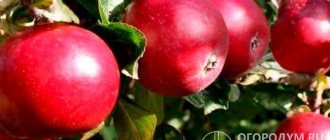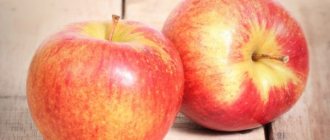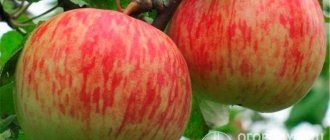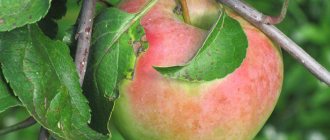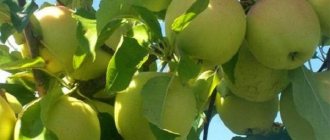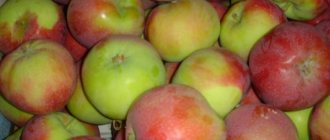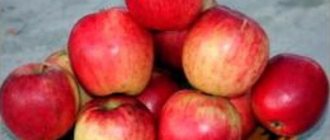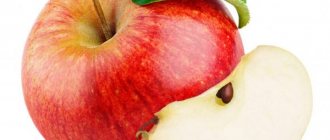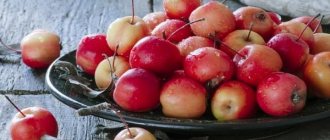What type does it belong to?
Early winter Bellefleur Bashkir is a sweet food variety with high taste.
It was bred for the steppe and forest-steppe zones of the Urals, widespread in Tatarstan and Bashkortostan.
Among the winter varieties, the following varieties also demonstrate good taste: Nimfa, Orlovsky Sinap, Kandil Orlovsky, Aport and Orlik.
Pollination
This variety of fruit trees is self-fertile; pollination occurs through proximity to other apple trees.
Fertilizers can be : Antonovka, Bashkir handsome, Anise Sverdlovsk, Titovka seedling, Titovka and any other varieties that coincide in the flowering period.
Fragrant flowers are resistant to early morning spring frosts.
Description of the Bellefleur Bashkir variety
The Bellefleur Bashkir apple trees inherited from their parents the slenderness and strong planting of round fruits on the branches. Let us dwell in more detail on the distinctive features of this fruit plant.
The tree is medium-sized, of a classic round structure with branches at right angles, the ends of which are directed upward.
The Bellefleur Bashkir apple tree has thick and strong branches and tolerates winter frosts quite well.
The leaf blades are large.
The tree is suitable for the role of a mother plant during hybridization; the root system easily accepts transplantation to a new location.
The fruits of Bellefleur Bashkir have a slightly elongated oval-round shape . The color is greenish, browned on one side with pink-red stripes and specks. The size of the apples is small, up to 150 g.
The apples have medium-length stalks, deeply planted in the funnel of the fruiting body. The seed nest is small with closed chambers, the seeds are medium-sized.
The tender pulp of apples has a light, fine-grained structure, a piquant sweet taste with a strong, pleasant aroma.
Bellefleur Chinese apple variety
Chinese women in the generally accepted sense are semi-wild, not very tasty and very small. But Bellefleur Chinese is the complete opposite, a variety with large apples that have a wonderful dessert taste. The tree is impressive, tall and spreading, producing large harvests. Fruit crops of this variety are widespread and have been cultivated for more than 100 years.
Bellefleur-Chinese apple tree variety.
Bellefleur-Chinese
The Bellefleur Chinese variety is a representative of autumn ripening, and in the southern regions it is even considered late summer. The apple tree was bred by Michurin, and he created very high-quality varieties. But the Chinese woman was present not only in the name, but also in the creation of the gene pool. The second variety whose genes were used was Bellefleur yellow.
Apple trees are very large, the shoots grow downward, creating a spreading crown. The huge apples are distinctive. Their size is indicated as 300 grams, but there are even half-kilogram samples. Apples look very cute, if such a characteristic applies to fruits.
Red stripes of different lengths are located in a chaotic manner along the light yellow surface.
Apple tree Bellefleur Bashkir
The Bellefleur Bashkir variety is the same Bellefleur Chinese, to which the genes of the local variety Bashkir handsome have been added. It began to be created already in the seventies, but has only been tested for about three decades. Their properties are almost identical, but slightly improved for cultivation in Bashkiria.
Apple tree Bellefleur Bashkir.
The apple tree is of medium height, usually grows up to 5 meters, the crown is spherical, simply huge in volume. Therefore, for planting you need to allocate a lot of space, up to 7 meters from neighboring plants.
The Bellefleur Bashkir variety cannot boast of huge yields, but it can easily withstand drought and decent frosts.
The shelf life of sweet fruits that have the same color is up to 5 months, and the apples are slightly smaller in size than the parent variety.
Characteristics of the variety
A more complete description and characteristics of the Bellefleur-Chinese variety will be presented below. As already mentioned, the main advantage will be the fruits.
They are large, attractive, very sweet and aromatic.
They don’t last very long, and it’s also impossible to transport them over long distances, but the fruits are universally used, so you can make many different delicious preserves, juices and dried fruits from them.
Advantages and disadvantages
This ancient variety has quite a lot of advantages. This is both unpretentiousness and amazing fruits, about which much has already been said. They are the undoubted pride of Bellefleur-Chinese.
It is worth mentioning the disadvantages. It was because of them that the variety was supplanted by younger and more promising hybrids. The resistance of the apple tree to low temperatures leaves much to be desired; the apple tree is mainly grown in the southern regions.
The amount of harvest is average, depending on the region it may be a little more or less. But it takes about 7 years to wait for the first fruits. Gardeners who are engaged in industrial cultivation do not really like this point.
Tree height
The Bellefleur Chinese apple tree is tall, even very tall. Without proper formation, its height can reach 10 meters. By the way, this is another drawback. It is not very easy to remove the fruit from the top.
Crown width
The volume of the crown of such a large tree is also quite impressive. The branches extend on different sides, forming a branched and dense crown. Its width can reach 6-7 meters.
Tasting assessment
It is not only the appearance of the remarkable apples that makes Bellefleur-Chinese so famous. Their taste is very pleasant. They have the perfect harmony of sweetness and a very light note of acidity, inherited from the Chinese. For taste, out of 5 they received 4.6 points.
Collected apple fruits.
The Bashkir subspecies is even sweeter. But since it is not distributed everywhere, there is no data on diagnostic and organoleptic indicators. The fruit has a surprisingly refreshing taste.
Winter hardiness
The variety's resistance to low temperatures is average, at least as indicated in official sources. In practice, it is grown in the south of Russia, the Caucasus, Armenia, the Lower Volga region and Ukraine. Already, even in the Central regions of the Russian Federation, the apple tree periodically freezes in the harshest winters.
Disease resistance
Bellefleur china is not the most immune apple tree and can get sick. The crown is very dense, which is a risk for fungi. Therefore, in humid conditions, scab is often observed, which seems to specially appear on large fruits.
A sign of fungal development on an apple tree.
Features of planting and care
The requirements for planting the Bellefleur Chinese and Bellefleur Bashkir varieties are identical, so we will talk about the characteristics and preferences of both of these related varieties.
Landing
There are two important requirements that must be taken into account: choosing the right seedling and location. Planting material must be purchased from trusted sellers and inspected for damage and exposure to pests. Before placing the seedling in the ground, the roots must be soaked in water for a day.
The landing site must be chosen carefully. It should be well lit and protected from strong wind gusts. It is necessary to choose a place on the site where groundwater is located as far as possible. The soil should be fertile and light. Loamy or sandy loam is best.
Apple tree planting diagram.
Deadlines
The exact planting date can only be determined based on the characteristics of the climate and region. But if we are talking about planting in the spring, then you need to choose a time after the soil has warmed up, but before the buds open. In autumn, planting should be done after the leaves from other apple trees have already fallen, but so that there are about 25 days left before the first frost. This is the end of April and the end of September respectively.
Technology
Landing is carried out according to one standard algorithm:
- Prepare the planting hole in advance and add organic and mineral fertilizers to it.
- In the center you need to make a mound of fertile soil and plant a seedling on it.
- Spread the roots well, cover with soil and water.
- Immediately mulch the tree trunk circle.
Distance
Taking into account the impressive size of the crown and height of the apple tree, it is necessary to properly maintain a distance from neighboring trees. It should be about 5 meters minimum. But you also need to understand that the variety is not self-fertile and needs pollinators, which should be located at a distance of up to 50 meters.
Scheme of distances when planting an apple tree.
Features of cultivation
If you once again pay attention to a number of disadvantages of the variety and its weak points, you can easily determine the characteristics of growing an apple tree. It is necessary to pay attention to the condition of the crown, protection of the apple tree from pests and diseases, and regular pruning.
Agricultural technology
Following proper care conditions will help increase the amount of fruit and improve immunity.
https://www.youtube.com/watch?v=y_W3aIgb-B8
Correct agricultural practices include:
- pruning and crown formation;
- preventive spraying with fungicides and insecticides;
- timely application of fertilizers during the season;
- timely watering of the tree;
- cleaning, loosening and mulching the tree trunk circle;
- protection of the trunk of young apple trees from rodents and low temperatures.
All these requirements are standard and apply when caring for any varieties of apple trees.
Pruning and crown formation
It is very important to begin the formation of the crown from the second year after planting. The Bellefleur Chinese apple tree is prone to thickening and growing too high, so it is very important not to neglect these procedures. A properly formed crown will help avoid many problems.
Proper pruning of an apple tree.
Pruning should be done for the first time in the second year of the apple tree’s life. The best time for this would be spring, before the buds open. It is better to create a rarefied form so that air passes well between the shoots and circulates freely.
You need to cut off wounded, frozen and broken shoots. It is also necessary to remove duplicate and top branches that grow inward and interfere with the full development of other shoots. Large cuts should be covered with garden varnish or oil paint to prevent infection from entering the apple tree tissue.
Breeding methods
One of the easiest ways to propagate the Bellefleur-Chinese apple tree variety is to grow it on a seed rootstock. The procedure is quite lengthy, requires a lot of preparation and a lot of time.
Features of ripening and fruiting
There are a number of features in fruiting that need to be taken into account. Some of them are off-putting to gardeners.
Beginning of fruiting
To get the first apples, you need to be patient. They can only be tried in 6-7 years. But this is not always the case. When planting an annual seedling in autumn, the first apples can be harvested only after 8 years.
Flowering time
The Bellefleur Bashkir apple tree variety blooms in the same way as the Bellefleur-Chinese apple tree variety - in May. Although many other apple trees bloom at this time. This is very convenient, because at the same time many of those varieties that are pollinators bloom.
Apple tree in bloom.
Fruit ripening
Usually the fruits are ready for picking at the beginning of September, in some places up to half the month. For storage, apples must be picked at the moment of ripening. But you can leave a small amount of fruit for eating. The fruits stay tightly on the apple tree until the coldest weather.
Fruit storage
The taste of the fruit can be preserved under the right conditions until December, in rare cases even until the New Year.
Features of fruiting
Apple harvesting takes place on last year's shoots and fruit twigs. The collection can be carried out every year without exception. An adult apple tree, over 20 years old, becomes even more productive.
Growing in regions
The peculiarities do not allow one to grow an apple tree everywhere, no matter how much one would like it. The variety is widespread in Armenia, the Caucasus and Ukraine. In the southern part of Russia only.
Moscow region
In the Moscow region, growing the variety is possible, but it is only better on a frost-resistant and semi-dwarf rootstock. But the fruits here do not gain maximum sweetness.
In the Urals
In this region, the Bashkir subspecies is more common, which is slightly more resistant. And not everywhere, but only in warmer parts.
Conclusion and tips
Despite all the shortcomings and features, many people plant this variety. It’s not for nothing that they call him Michurinsky, because the name of the breeder speaks for itself. Bellefleur Chinese has amazing fruits, huge and very tasty.
Of course, the variety needs additional protection and special attention. But the more valuable it is and will delight you with its fruits.
PreviousNext
Source: https://NaYablone.ru/sorta-yablon/belfler-kitayka
Photo
History of selection
The famous ancestors of the new hybrid are the Bashkir beauty and the hybrid from the gardens of the great breeder I. Michurin - Bellefleur Chinese.
Varietal breeding took place in 1938 , thanks to Raisa Ippolitovna Bolotina .
She worked at the Bashkir Research Institute of Agriculture and, together with her colleagues, developed many wonderful varieties of apple trees, pears and currants.
The Bashkir Bellefleur variety was taken seriously only in 1991, and now it is widely known and often found in collective gardens of the Soviet era.
Reviews
Lidia Ivanovna I. “No one can say for sure how old the tree in our garden is. But definitely under forty. We call him Bellefleur. And Chinese. And also michurinka.
Huge in size. This is after numerous updating trims. The apples are not very large. But very tasty. Every year .
I wouldn't say that he needs any special care. As for all apple trees. And no one is going to clean it up. Although we have plenty of other varieties.
It is advised to vaccinate on a frost-resistant variety. But he winters normally anyway.”
Stepan Alekseevich M. “There are many varieties of apples in our garden. But among the autumn ones, I really like Bellefleur Chinese, which I bought after I came across a photo and description of the variety. With its size and very tasty apples . Especially if they lie down for a while. We have them after White Filling.
More on Tele4n.Net:
Apple tree Enterprise: description, photos, reviews
Enough for juices and jams. They don't last long. But we have enough winter varieties. Somehow I missed treatments for scab. It took 3-4 years to correct the error. There is enough copper sulfate and urea.”
Nadezhda Semenovna P. “Many are unfamiliar with the Belfleur Bashkir apple tree variety. And here it is one of the most common.
Well suited for growing in our conditions. Although treatments for diseases are needed. As well as from pests. Sometimes it freezes. But there is a harvest every year. Decent. Somehow I’m not used to weighing. And they are stored well.
After the New Year we still eat them. Good quality . It's just interesting. They were brought out back in the thirties. Were they recommended for cultivation in the nineties?”
Alexander Sergeevich S. “I didn’t plant this variety myself. Got it with the dacha. It turned out to be Bellefleur. And I found out that he was Bashkir much later, I came across a description and photo.
There were thoughts of replacing it with new varieties. But the hand does not rise to remove it. I’ll try to vaccinate... And we’ll see. But I have a greater desire to instill not Bashkir, but Chinese.
The size of this Michurin variety is very attractive. It's not for nothing that he has been so popular . And over such a vast territory.
And we can work on disease resistance. It’s not called a souvenir for nothing. And they still take it to exhibitions now.”
Region of natural growth
The hybrid was bred in Bashkiria to be moderately frost-resistant tolerate summer drought remarkably well
The tree bears fruit well in all regions up to 50 degrees north latitude, that is, it is suitable for planting in many regions of Russia.
The following varieties are well suited for planting in this region: Uralets, Yantar, Uralskoye Nalivnoye, Serebryanoye Kopytse and Isetskoye later.
Productivity
Excellent yield ( 50-80 kg per tree ) and good keeping quality and transportability of fruits have become one of the conditions for the commercial distribution of this apple variety.
The apples are held quite firmly on the branches and can withstand strong winds without falling prematurely. Fruit harvesting from September, excellent preservation until February.
The following apple varieties can also guarantee high yields: Lobo, Antey, Lyubava, Kuibyshevskoye and Imrus.
Apple tree Bellefleur Bashkir
In the Astrakhan region, the Belfleur Bashkir variety grows well. I do not recommend growing it in humid regions; the tree loves dry climates and is highly resistant to drought. But the durability and winter hardiness of the tree are average. My tree has been growing for 16 years, I really hope that it will continue to please me with its harvest, although in the last 2 years the yield has decreased, quite possibly this is due to aging. This variety is not for everyone's taste, because the fruits are somewhat bland with a slight sweet aftertaste and will appeal to those who are on diets and adhere to PP. The most optimal harvest time is the first ten days of September. If you remove them earlier or later, they will be stored worse, but they will remain there for a long time until the end of February. They don't come off very easily because they are attached well. My apples are always greenish-yellow in color, some have a pink tint, and the waxy coating is very small. The tree is medium-sized, the crown is dense, rounded, the bark is smooth, greenish. The main damage to Bellefleur is caused not by scab and powdery mildew, but by the codling moth. I do double sprays with a solution of Parisian greens, but keep in mind that this is a strong poison, immediately after flowering and in early June.
The seedlings of this early winter variety took root easily; we did not make any special efforts. They dug standard holes - about a meter deep, also a meter in diameter, fertilized a little with humus and then planted them. After this, be sure to water well for a couple of weeks, this will help the apple trees take root in the new location. The landing site was chosen to be sunny and windless. The variety tolerates summer drought well; we water it only when possible. These trees grow tall, with a spreading crown, so we had to leave a distance of 6 meters between the trees. The obligatory thing is to do pruning in early spring and whiten the trunks of apple trees. We also treat the entire garden with Bordeaux mixture to prevent scab. This variety produces good harvests - up to 80 kg from 1 tree. The apples hold well on the branches during the wind and do not fall off. Store quietly in a cool, dry place until February.
Planting and care
Even experienced gardeners do not always know how to plant a fruit tree correctly. Let's use the advice of breeder I.V. Michurin, based on the many years of experience of this great scientist-practitioner.
A few important planting rules:
Digging up the entire area intended for planting trees at least 2 shovels deep or plowing with a walk-behind tractor and plow.
It is advisable to plant two-year-old grafts.
Medium-sized apple trees on a personal plot are planted at a distance of four meters in a row, with a gap of 6 meters between rows.
In large areas of a commercial garden, for higher yields, trees should be spaced 7 meters apart, with a gap between rows of 10 meters.
The planting hole, according to the advice of I. Michurin, needs a depth and width of 1 meter earth with humus is poured onto the bottom of the hole , such as a mound.
A peg, previously cleared of bark, branches, and irregularities, is stuck through the middle of the mound into the hard bottom of the pit. A tree is placed on top of the earthen fill, so that the root collar rises two fingers above the soil level ; when the soil settles, the tree will sink.
There is no need to plant deeply; ideally, if the transplanting level coincides with the planting level in the nursery, a little higher is possible.
The roots of the plant should be spread wide in the planting hole and directed downwards. Root ends damaged during pre-sale digging are first cut off with a sharp knife.
It is great if, before planting (the night before), the roots of the tree are dipped in a solution of yellow clay, half mixed with fresh cow dung or a good liquid organic fertilizer.
After planting, the soil around the trunk is trampled down, then watering is required (3-4 buckets of water) . Watering in the first year after spring planting is done every week (during dry times).
To avoid sunburn, you need to tie the tree with straw, leaving the crown (if any) or 4-6 upper buds.
Planting is possible both in the spring , before the first leaves appear, and in the fall , late September, October (if the soil is sufficiently moist, if it is dry, postpone until spring).
Care consists of loosening and weeding the soil every summer.
to prune two to three year old trees , leaving 4-6 buds on each new shoot.
Pruning should be done in early spring, before the sap flows, and can be covered with simple oil paint (the composition should not contain oil, gasoline, kerosene, etc.).
Other garden work:
- in April, caulking and tying up trees damaged by hares and mice, preliminary pest control (aphids) - spraying with chemicals;
- in July, pruning dry and damaged branches, loosening the soil;
- weeding the grass in August;
- in September, digging up trees;
- in November, trampling snow at the roots of trees to prevent rodents (hares and mice);
- in December, the destruction of caterpillars hibernating on the bark in dry bundles of leaves.
Diseases and pests
Apple codling moth (caterpillars damage fruits and contribute to large drops). To get rid of the codling moth, double spraying with a solution of Parisian greens (strong poison) in proportions of 100 g per 16 buckets of water is carried out immediately after flowering and in early June, when the ovary has reached the size of a hazelnut.
Apple aphid. Destroyed with a solution of 200 g of crushed laundry soap per bucket of warm water with the addition of one glass of thick tobacco decoction (shag), a quarter glass of kerosene, ground with a half glass of wood ash. It is advisable to dip infected branches into a bowl of mixture or treat them with a sponge or large brush.
Scab, a fungal disease, appears as a grayish-greenish coating on the wrinkled bark of a tree. It is removed by spraying diseased trunks with 2% Bordeaux mixture in early spring. Treatment should occur before buds develop and shoots appear.
It is also worth taking measures against fruit sapwood, leafmining moths, hawthorns and silkworms.
Growing a good harvest of apples is a gardener's dream. It becomes real if you plant good varieties of fruit trees. Bellefleur Bashkir is one of these.
Its advantages are excellent taste (sweet), average frost resistance, high yield, good transportability and shelf life.
If you find an error, please highlight a piece of text and press Ctrl Enter.
Most often, the following pests and diseases are found on Bellefleur Bashkir:
- Apple codling moth (caterpillars penetrate inside the apple, thereby causing carrion). To exterminate the insect, trees are sprayed during the flowering period, when the ovary reaches the size of a walnut. Paris green is used as a chemical. The substance is very poisonous.
- Apple aphid. To remove this insect, use a solution based on laundry soap, a strong decoction of tobacco, kerosene and wood ash.
- Scab. The first signs of scab on trees is the appearance of a gray-green coating on the bark. To remove the disease, use a solution of 2% Bordeaux mixture. Trees are treated in the spring, before buds and shoots appear.
We invite you to familiarize yourself with: Porch tiling – Porch tiling
In addition to these diseases, gardeners are faced with hawthorn, fruit sapwood, silkworms and leafminer moths. To prevent diseases and insects, trees should be inspected regularly. And when the first signs appear, begin the fight before insects or diseases damage the tree.
